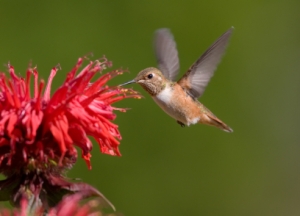 If you delight in fruity minty fragrance and the sight of hummingbirds hovering above brilliant tubular blossoms, try your hand at growing bee balm. This Native American herb, also called wild bergamot and Monarda, is available in crimson, pink, and purple flowers. My favorite varieties are the red ones. They also seem to attract more hummers, at least in my yard, but the other colors are lovely too.
If you delight in fruity minty fragrance and the sight of hummingbirds hovering above brilliant tubular blossoms, try your hand at growing bee balm. This Native American herb, also called wild bergamot and Monarda, is available in crimson, pink, and purple flowers. My favorite varieties are the red ones. They also seem to attract more hummers, at least in my yard, but the other colors are lovely too.As its name suggests, bee balm is attractive to honey bees. Butterflies also favor it. The red variety is commonly known as Oswego Tea and was used by colonists in place of English Tea after the Boston Tea Party, when they threw the English tea in the harbor to protest the tax imposed on it by the British.
To make a cup of tea, place a tablespoon of fresh or one teaspoon of dried bee balm leaves in a tea strainer or tea spoon and pour one cup of boiling water over it. Allow it to steep for ten minutes and bring the tea out. Sweeten if you wish and enjoy. The leaves can be chopped and added to salads. Flowers can also be used for tea or salads, but in my thinking that’s just wrong.
 Bee Balm has a long history of medicinal use by American Indians and settlers, primarily for stomach and bronchial ailments, and is the source for the antiseptic derivative called Thymol. I haven’t used the plant medicinally, but enjoy its beauty and delicious scent in the garden. Hummingbirds appear without fail when my patch of bee balm thrives. Recent droughts have hurt it, so this year I’m setting out yet more starts of this invaluable herb. *Note I wrote the bulk of this post last spring, so can now report in and say that the plants I set out then made it! Woo hooo! But I’d still like more. I’m quite greedy when it comes to bee balm.
Bee Balm has a long history of medicinal use by American Indians and settlers, primarily for stomach and bronchial ailments, and is the source for the antiseptic derivative called Thymol. I haven’t used the plant medicinally, but enjoy its beauty and delicious scent in the garden. Hummingbirds appear without fail when my patch of bee balm thrives. Recent droughts have hurt it, so this year I’m setting out yet more starts of this invaluable herb. *Note I wrote the bulk of this post last spring, so can now report in and say that the plants I set out then made it! Woo hooo! But I’d still like more. I’m quite greedy when it comes to bee balm.You can grow bee balm in among other plants, but take care that it isn’t crowded out, a mistake I’ve made. And it’s susceptible to mildew, so sunshine and good air circulation are important. Some recommended companion plants for bee balm are: purple coneflower (Echinacea purpurea), black eyed Susan (Rudbeckia), and lavender (Lavandula).
 The Old Farmers Almanac (Online site) has a super piece about plants to attract birds and creating a bird friendly habitat. They say: “Hummingbirds are happy with nectar from bee balm…The key to attracting hummingbirds to your yard is to plant lots of flowers and provide the habitat that will give them shade, shelter, food, and security.”
The Old Farmers Almanac (Online site) has a super piece about plants to attract birds and creating a bird friendly habitat. They say: “Hummingbirds are happy with nectar from bee balm…The key to attracting hummingbirds to your yard is to plant lots of flowers and provide the habitat that will give them shade, shelter, food, and security.”For more from this valuable resource visit The Old Farmer’s Almanac and register for their free newsletter. It’s loaded with valuable info. The site also offers lovely cookbooks, gardening journals, handy garden snips… for sale. They have a special Mother’s Day offer on now. Not to mention that they are often spot on with their weather predictions.












Lovely, Beth. The flowers are gorgeous, and I'm going to make a point of trying bee balm tea.
Awesome post, Beth. I have Butterfly plants anchoring my glass doors and the Hummingbirds love them too. Bee Balms look so pretty. I need to check them out.
Beauitful pictures.
Thanks Barbara. Yes, Autumn, Butterfly plants are also a wonderful addition to the garden. Do try bee balm.
I've looked it up already, along with blue potatoes for the veggie garden. I'm itching to get outside today and move some thing around, but I need to write two more pages atleast. Darn goals. LOL.
I have to write too! We LOVE blue potatoes here. They taste wonderful.
I am dying to know what the tea tastes like. It won't grow here. But hummingbirds are a rare sight in the subtropics of Florida. Have you ever tasted the tea Beth?
It's one of the essential ingredients of Earl Gray which I love. But no, not the plain tea. I shall do so and report back.
Interesting, Beth! And as always you have gorgeous photographs. Your garden and farm must be beautiful! Enjoy Spring!!
Beth you are such a talented person. You make me want to try gardening again.
I'm going to look for some bee balm to add to my garden this spring.
Melba Moon
President-elect KOD